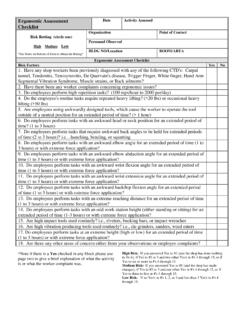Transcription of Pronunciation Problems of Chinese Learners of English - ed
1 26 ORTESOL Journal Increasingly Chinese students are pur-suing their studies abroad in English speaking countries, such as the USA, the UK, Australia, and New Zealand. Despite the fact that they have studied English as a compulsory subject for a number of years and have passed multi-ple English proficiency tests, many still find it is difficult to communicate well in spoken English . One of the major obstacles for oral communication is undoubtedly English pro-nunciation, which hinders many Chinese stu-dents ability to be understood by native speakers or English Learners from other lan-guage backgrounds.
2 Foreign language (FL) Learners mis-pronunciations are not random, as a foreign accent produced by Learners largely reflects the phonetic features and intonation character-istics of their first language (L1) (Avery & Ehrlich, 1992; Ohata, 2004; Swan & Smith, 1987). This article first examines some of the differences between Chinese and English pho-nological systems and then summarizes some of the English Pronunciation Problems for Chinese Learners . Ideally, this article will help TESOL practitioners become aware of the way in which Learners L1 backgrounds may influence their English Pronunciation .
3 In par-ticular, it is useful for English teachers with Chinese students to have some knowledge of the phonological differences between English and Chinese as well as the major problematic areas in terms of Pronunciation . Analysis of Problems Chinese Learners of English have prob-lems with English Pronunciation both in seg-mental aspects and in suprasegmental aspects. Problems in segmental aspects are primarily concerned with the articulation of single phonemes or combinations of phonemes in both vowels and consonants. In supraseg-mental areas, Chinese Learners are found to have Problems with stress and intonation.
4 In the following paragraphs, these Problems are presented by contrasting the phonology of Chinese and English . Additionally, possible causes are identified and detailed examples are provided to illustrate problematic pro-nunciation. Problems with vowels In comparing the phonological sys-tems of Chinese and English , Chinese and English differ greatly in the number of vow-els. While English has 15 vowels (Ohata, 2004), Chinese has only 5 vowels (San, 2007). Because of this difference, Chinese Learners need to learn how to pronounce many new vowels when they start to learn English .
5 Even when a vowel exists in both Chinese and English , the sound s manner of articulation and place of articulation is dif-ferent from that in English . With respect to the manner of articulation, consider the Chi-nese vowel [ ] and English vowels [ ] and [ ]. In Chinese , there are no minimal pairs of the long vowel [ ] and short vowel [ ], whereas in English the long [ ] and short [ ] form minimal pairs. This means that the length difference for articulating the two vowels changes the meaning of words in which the sound appears. Most Chinese Learners do not distinguish the long [ ] from the short [ ] when they speak English .
6 In- Pronunciation Problems of Chinese Learners of English Feifei Han, University of Sydney Volume 30, 2013 27 stead, they tend to maintain the same length when articulating them in different words, such as ship / p/ (sheep) and / p/ (ship). It is also common for Chinese Learners to replace both English [ ] and [ ] with the correspond-ing Chinese vowel, which requires a higher and more frontal position of the tongue for Pronunciation . Hence, this illustrates how the location of articulation can be problematic, even when a vowel exists in both languages.
7 A similar problem caused by differing loca-tions of articulation between Chinese vowels and English vowels is evident in Chinese Learners Pronunciation of the English [ ] and [ ], which is similar to the Chinese vowel [ ]. Although the position of articulation for the Chinese [ ] is higher compared to English [ ] and [ ], Chinese Learners only try to extend or reduce the length of the Chinese [ ] to pro-duce [ ] and [ ] respectively. When Chinese Learners pronounce the words cart and cut , which are minimal pairs, there is often only a difference in the duration of articulation, whereas English speakers change the tongue s position to generate the two vowels.
8 Just as English monophthongs tend to generate Problems for Chinese Learners , the diphthongs can also cause difficulties. For in-stance, because of the mispronunciation of monophthongs [ ] and [ ], the diphthong [ ] resulting from [ ] and [ ] also tend to be misarticulated. In fact, Chinese Learners often confuse [ ] with [ ] and [ ]. Consequently, native English speakers often find it hard to follow Chinese Learners when they try to say bide , bad and bed . Likewise, the Eng-lish diphthong [ ] tends to be mixed with [ :] and [ ]. Therefore, it can be hard to distin-guish Chinese Learners Pronunciation of house and horse.
9 Problems with consonants Chinese and English have roughly the same numbers of consonants. However, some English consonants do not exist in Chinese . This poses difficulties for Chinese Learners trying to produce these consonants. As noted by Zhang and Yin (2009), one common strat-egy used by FL Learners to produce phonemes that do not exist in their L1 is to substitute similar phonemes from their L1. Such substi-tutions by Chinese Learners are frequently ev-ident in their English Pronunciation of conso-nants. For instance, Chinese speakers gener-ally have trouble with dental fricatives [ ] and [ ] in English as there are no dental frica-tives in Mandarin Chinese (though there are dental fricatives in other Chinese dialects).
10 Typically, the two dental fricatives [ ] and [ ] are substituted with two similar alveolar fricatives, [s] and [z]. In order to counter these Problems , experienced teachers should always emphasize the differences between dental fricatives [ ] and [ ] and alveolar fric-atives [s] and [z]. Sometimes Chinese Learners will pro-duce two English consonants interchangeably because the two consonants, which form a minimal pair, have only one similar conso-nant in Chinese . For example, in Chinese the consonant [v] only appears as an allophone of [w], therefore, altering the two does not cre-ate a difference in meaning.












